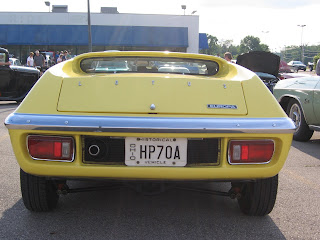
HST 344 -- Science, Technology and the Modern Corporation: The Automobile and American Life
Class Meeting: MTWTHF 9:25-10:40 a.m., HM 125
Instructor: John A. Heitmann
Office: 435HM (x92803).
Office Hours: By appointment
E-Mail: John.Heitmann@notes.udayton.edu
Blog: http://automobileandamericanlife.blogspot.com
Texts: John Heitmann, The Automobile and American Life.
Ben Hamper, Rivethead.
Lee Iacocca, An Autobiography.
Grades: The final grade for this course will be based upon one Mid-Term Exam, (30%), Two Critical Book Reviews (40%), and Final Exam (30%). The grade scale is as follows: A 94 to 100; A- 90 to 93; B+ 87-89; B 84-86; B- 80 - 83; C+ 77-79; C 74-76; C- 70-73. A similar pattern applies to lower grades. Letter grades are assigned a mid-point numerical grade. Additionally, attendance can influence your final grade at my discretion: if you miss more than 2 classes, one letter grade will be deducted from your grade; if you miss more than 4 classes, a two letter grade reduction will take place. Grade averages may be influenced by such factors as trends over the time of the course; for example, how you finish is far more important than how you start. Policies for exams strictly follows History Department Guidelines, and make-ups will only be offered with a valid, documented excuse.
Critical Book Reviews: Three critical reviews of assigned books serve as integral assignments in this course. Each review should be 3-5 pages in length, typed, double spaced. One should aim to critically summarize the book, aiming sure to discuss the authors content, themes, and perspectives, and then also provide an introspective response to the book that incorporates one’s own evaluation of the work’s authenticity and value.
Attendance at lectures is crucial if you are to expect a good grade in the course, and I want you to be at every class if that is at all possible. On many occasions material presented is not covered in the readings, and so many of the ideas discussed central to the development of modern science are complex and often confusing. Your attitude and what you bring in to the classroom can make the difference between a mediocre offering and a most positive educational experience.
Cheating and plagiarism will not be tolerated and offenses will be punished accordingly. A first offense will result in a failing grade for the exam or paper in question; a second offense will result in a failing grade for the course.
Course Purpose: It has been said that the automobile is the perfect technological symbol of American culture, a tangible expression of our quest to level space, time and class, and a reflection of our restless mobility, social and otherwise. In this course we will explore together the place of the automobile in American life, and how it transformed business, life on the farm and in the city, the nature and organization of work, leisure time, and the arts. This is a most complex transition that we will study, as the automobile transformed everyday life and the environment in which we operate. It influenced the foods we eat; music we listen to; risks we take; places we visit; errands we run; emotions we feel; movies we watch; stress we endure; and, the air we breathe.
SCHEDULE OF LECTURES AND ASSIGNMENTS
The week of:
Week 1/June 27 Introduction; What our cars tell us about ourselves. The car in everyday life: the automobile age and its contradictions. Automotive Pioneers; Putting America on the Road; Henry Ford and the Model T; The Rise of General Motors; “Master Hands.”
Reading: Heitmann, .Introduction, Chapter 1-3.
Films: “Wild Wheels”; “Horatio’s Drive;” “Automobile Parade;” “Gussle’s Day of Rest”
Monday, July 4, Holiday!
Week 2/July 5 Advertising, Styling, Design and the Art of the Automobile
On the Road;
Reading: Heitmann, chapter 4.
Film: “Grapes of Wrath;” “Route 66;" “Detour.”
Review of Hamper’s Rivethead is due on July 6
Week 3/July 11 Religion, Sex, and The car as a Home
Reading: Heitmann, Chapter 5
Film: “Automobile Advertising 1910-1940;” “Thelma and Louise”; “Motorcycle Diaries”
Mid-Term Exam is July 15
Week 4/ July 18 The Interwar Years: The Great Depression, Aerodynamics, and Cars of the Olympian Age
Readings: Heitmann, Chapter 6.
Films: “The Crowd Roars;” “Burn Em’Up Barnes.”
Week 5/ July 25 World War II: Detroit, the Arsenal of Democracy; The Post War Industry and Technological Suppression; Chrome Dreams of the 1950s
Readings: Heitmann, Chapters 7-8.
Film: “Jitterbugs;” "Tucker;" "Rebel Without a Cause;" "Thunder Road;" "American Graffiti;"“Goldfinger;” “Thunderball” “Bullitt.”
July 27 Review of Lee Iacocca’s 's Autobiography is due.
Week / 6 August 1 Oil Shock I: Japan, James Bond, and Mobile Lovemaking; The Automobile World Upside Down, 1980s to the Present.
Readings: Heitmann, Chapters 9-10, Epilogue.
Films: “Gone in Sixty Seconds.” “Fast and Furious;” “The Bourne Identity.”
Final Exam, Friday August 4 9:25-10:40 a.m.
 Beside the County Clerk's Office, Sutton, WVA.
Beside the County Clerk's Office, Sutton, WVA.


 Main Street, Sutton, WVA.
Main Street, Sutton, WVA.























